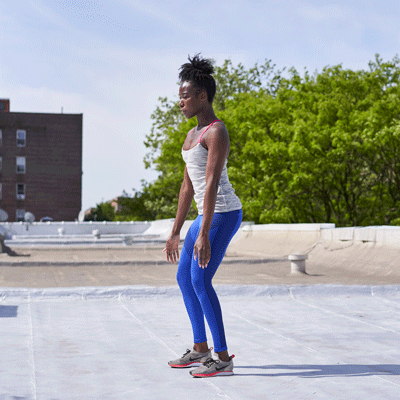On a mission to get buns of steel? Try incorporating air squats into your leg day routine and you’ll probably notice a difference pretty quickly.
Air squats are like regular squats, but instead of using additional weights, you use only your body weight (hence why you may also know them as bodyweight squats). They’re often part of CrossFit and similar workouts, and they work your thighs and glutes.
They’re easy to master and very effective at tightening up those booty muscles. And because you don’t need to use additional weight, air squats are a perfect move for an at-home workout.
Before doing air squats, be sure to stretch and warm up.
Master the move
- Stand with feet shoulder-width apart, toes pointed slightly outward.
- Engage core muscles and pull shoulder blades together slightly to push out your chest.
- Squat back as if you were about to sit in a chair. Keep your weight in your heels so you don’t lean forward. Your hips should move down and back.
- Make sure your lower back curve is maintained and keep heels flat on the floor the whole time. Hips will descend lower than knees. (The eventual goal is to touch your glutes to the backs of your calves.)
- Hold for a few seconds, then rise up by pushing through heels and using glutes to return to a standing position.
Pay close attention to maintaining proper form, even if that means moving slowly. When doing an air squat, you’ll want to remember these tips:
- Your knees should never go past your toes.
- Angle your toes slightly outward (while still keeping them mostly straight) to prevent knee pain.
- Your back should not be rounded.
- Don’t drop your shoulders forward. Your upper body should stay still, and only your lower body should move.
- Keep your eyes fixed on a point directly in front of you to keep your chest lifted.
- Keep all your weight in your heels to keep yourself from pitching forward.
When you do air squats, you should feel the move in your thighs and glutes. If you’re feeling pain elsewhere, that means you need to correct your form.
If air squats cause pain in your knees, that means you’re either going too low or not using correct form. It could mean you’re putting more weight toward your toes than your heels.
If you have lower back pain during or after doing air squats, that could mean you’re leaning your chest forward too much. Avoid leaning forward when doing this move.
The benefits of air squats go beyond an enviable backside.
- Think of air squats as an introduction to weighted squats. This move will help you learn the proper form for weighted squats so you can do them safely and lower your risk of injury.
- Air squats strengthen your glutes, but they also build a solid foundation of strength for your entire lower body. They can also work your thigh muscles, including your hamstrings and quadriceps.
- Because air squats require balance, they can even work your core muscles.
- Air squats can make your legs stronger and more powerful, which can positively impact any other workout you do, whether it’s cardio or strength-based.
If you experience sciatic nerve pain, you shouldn’t do any kind of squat without first speaking with your doctor and/or physical therapist. If you feel dizzy or lightheaded, stop doing this exercise.
Air squats are an incredibly effective beginner workout move. They work your glutes, hamstrings, and quadriceps and even help you improve your balance and core strength. Doing air squats will help you learn other leg exercises down the line.


